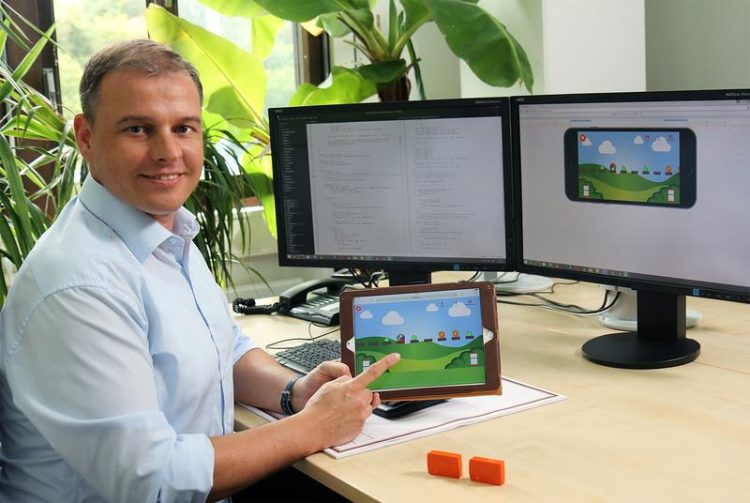Medica 2018: Control with your feet – computer game to help prevent thrombosis

Steffen and his colleagues have developed the computer game “jumpBALL”. Credits: Koziel/TUK
Thrombosis is the third most common cardiovascular disease after heart attacks and strokes. The risk group mainly includes elderly people, but also patients who are bedridden due to an illness or have undergone major surgery.
In order to prevent thrombosis, targeted movement exercises such as the rocker foot, also known as the muscle vein pump, help. “First, the toes are stretched far forward and then pulled as far as possible towards the body,” explains Daniel Steffen, computer scientist in the wearHEALTH junior research group at the Technische Univerität Kaiserslautern (TUK).
This movement should be repeated with both feet as often and regularly as possible. “This exercise, however, is very monotonous and tiring, so patients are usually not very motivated,” Steffen continues. “We know from studies that about 65 percent of patients do not do such exercises or do them only partially.”
This is where the computer game “jumpBALL” comes in, which Steffen developed with his colleagues, the psychologist Dr. Corinna Faust-Christmann and the computer scientist Dr. Gabriele Bleser, as well as the physician Dr. Markus Muhm from the Westpfalz-Klinikum in Kaiserslautern. In the game, a water ball jumps over tree trunks on which various items such as coins, diamonds, stars or monsters are located.
If the ball hits one of the first three items, the player receives bonus points. If the ball lands on a monster, points are deducted. What is special: The player must control the game with his feet. “While playing, he performs the muscle vein pump,” says Steffen. In this context, experts speak of “exergaming.” “Video games are combined with physical exercises,” continues the scientist.
Not much technology is needed for the game besides a smartphone or tablet: There are two small wireless sensors attached to the feet with Velcro straps that record the movements. “With the left foot, for example, the water ball is triggered to jump one tree trunk further, with the right foot, the ball jumps to the next but one trunk,” Steffen continues.
In studies, Steffen's team has already investigated how well the game promotes motivation. It also checked how often and for how long participants perform the exercises and how usable the system is. Elderly people also took part in this test. “We noticed that the senior test persons got along very well with jumpBALL and even had more fun than younger study participants,” says the computer scientist.
The game jumpBALL is mainly aimed at elderly people or patients for thrombosis prophylaxis. In addition, it can be used during rehabilitation, for example for patients after a stroke or after hip or knee surgery. Therefore, the sensors would only have to be mounted on the lower or upper thigh.
But the technology is also interesting for encouraging people in intensive care units to make slight movements. It is also suitable for people who suffer from arterial occlusion, as is the case with the shop window syndrome (claudicatio intermittens), for example. Here, too, the computer game could be used to motivate movement. The wearHEALTH team presents the game at the Medica.
The Kaiserslautern junior research group wearHEALTH is an interdisciplinary team from the fields of computer science, mathematics, psychology, cognitive science, motion science and control engineering.
They develop digital techniques that are intended to improve health preventively or, for example, in the form of rehabilitation measures. The team is funded by the Federal Ministry of Education and Research as part of the “Interdisciplinary Competence Building in the Research Focus Human-Technology Interaction for Demographic Change” measure.
Daniel Steffen
AG [working group] wearHEALTH
E-mail: steffen[at]cs.uni-kl.de
Media Contact
More Information:
http://www.uni-kl.deAll latest news from the category: Trade Fair News
Newest articles

Bringing bio-inspired robots to life
Nebraska researcher Eric Markvicka gets NSF CAREER Award to pursue manufacture of novel materials for soft robotics and stretchable electronics. Engineers are increasingly eager to develop robots that mimic the…

Bella moths use poison to attract mates
Scientists are closer to finding out how. Pyrrolizidine alkaloids are as bitter and toxic as they are hard to pronounce. They’re produced by several different types of plants and are…

AI tool creates ‘synthetic’ images of cells
…for enhanced microscopy analysis. Observing individual cells through microscopes can reveal a range of important cell biological phenomena that frequently play a role in human diseases, but the process of…





















